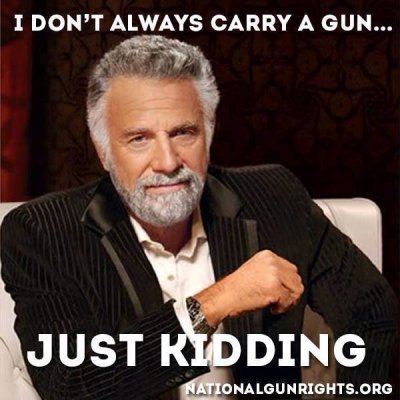Ramblinman said:
have read that profession Ials wait until a charging animal is in close before discharging a firearm
... I have always played in out in my head that the charge MAY occur from another direction other than in front of me which MAY require a draw from the holster to address a more dynamic situation i.e.: left or right ...
A revolver appeals to me because I shoot regularly and there MAY be an opportunity to engage the bear while it is eating you- drawing and shooting in the torso or head. Hopefully their is some muscle memory that will let me draw and shoot.
BTW I agree keeping the spray in the holster is an excellent technique in so far as situation permits ... but we should prepare for all eventualities.
Part of the issue of waiting is, you never know if its a bluff charge until the last minute. Theres metric boatloads of testosterone fueled, uninformed comments about people saying they plan to shoot any bear that looks crossways at them or comes within a half mile, but those folks tend to end up in federal prison or wherever they throw you for shooting animals on the ESL without good reason. The feds or state use THEIR critera, not yours, to establish if it was neccesary. Bears often bluff charge. Learning their body language and habits helps. Still, no guarantees either way whats going to happen until it does,...or doesnt.
Ace! said:
My inexperienced self says you need penetration, so I would carry something (rifle) that will handle heavy solid cast bullets or a magnum. I don't think it is likely to un-holster and use a revolver while being eaten, so it comes down to a rifle shot within close range.
I've seen videos of guides protecting clients/themselves by shooting bears and they always took close range shots. I'm sure these are high adrenaline situations and you get one or two shots. With heavy cast bullets, pushed at high(er) velocities, in a revolver you have to be GOOD to shoot them where you want the second time at speed. I think you'd do well to carry a rifle if you're going to carry a firearm. A revolver wouldn't be much use, in my opinion, on a large bear. And in that case, you'd have to hit the central nervous system or it's just going to keep eating you anyway. A lung or heart shot may kill it, but not before it finishes eating you.
Yes, penetration is king when shooting charging bears. Many hunting rifle loads dont penetrate as well as heavy handgun loads with solid, non-expanding bullets.
Rifles are great if you are in the open or have time and chance to use them, once contact is made, which is sometimes the first indication you have a bear problem, they arent much use. People have been broadsided by bears and lost their rifle, or had them unavailable. If the bear is standing on you, its pretty unavailable even if its under you or in your hand. That is the moment a handgun shines. You wear a pistol, you carry a rifle/shotgun. You can lean a long gun against a tree and not have it in hand when life gets interesting. A pistol can live comfortably on your belt full time when out (though some defeat the purpose of a pistol by buying huge, heavy, awkward, long barrel mostrosities and end of not wearing them) There was a guy in Wy that killed a bear right after it broadsided him out of the blue and chewed him up badly, then acting like it was coming for more. He fired 3 rounds with a 41 magnum single action, made two hits, complete pass throughs, and killed the sow grizzly on the spot. Another guy in Alaska was mugged by a bear and managed to shoot it several times with a single action 44 mag as it was on top of him. These are only two that come to mind off the top of my head.
CNS hit is the only sure way to shut down a bear or large animal. Breaking down large bones can buy you a few seconds of time. Some bears have been shot with pistols and had the bullet shoot all the way through and break a hip, turning it or slowing it and allowing finishing shots. I've seen a number of comments on various forums about shooting bears in the eye to make a brain shot. Bears eye sockets are outside the brain pan, they are not like human skulls at all. Skulls arent armored either. A shallow angle can skip a bullet off, a heavy bullet at a steep angle isnt so likely to. Read up on Ralph Emory (believe thats correct), he wrote a book, Crusoe of Lonesoime Lake. He lived in BC in the early 1900s and built a homestead out of wild country. He said he stopped counting at 50 the number of grizzlies he killed. Most were head shots, and most with either a 30-30 Winchester 94 carbine or a Remington 35 cal model 8 automatic. Just saying, bears dont require artillery to kill, or ninja skills.
Yeah, it can get scary, just like car wrecks, earthquakes, people having heart attacks and other things that happen in life sometimes. It doesnt take superhuman abilities to cope. Many people do just fine when things go south. Thinking things through and having some idea wha to do, or some rough plan gives a start to dealing with it. Unofrtunately, many get the silly idea its hopeless if something bad happens, they have effectively defeated themselves before it ever starts.


